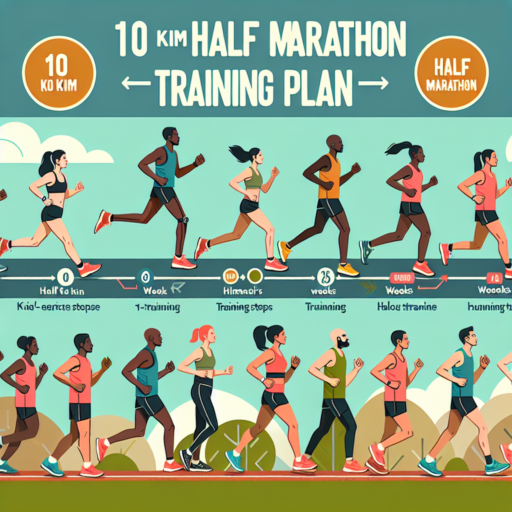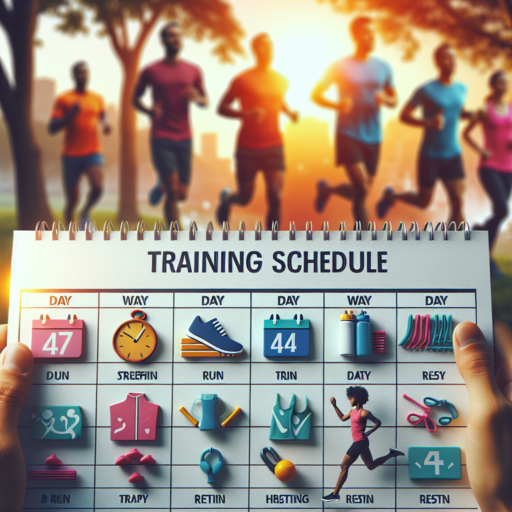Introduction: From 10 km to Half Marathon – Your Ultimate Training Guide
Embarking on the journey from running a 10 km race to conquering a half marathon is an exhilarating leap that requires not only physical endurance but also mental preparation. This transformation isn’t just about doubling your distance; it’s about exploring the depths of your determination and stamina. In this definitive guide, we’ll walk you through essential tips and steps to ensure your transition is both successful and enjoyable.
Understanding the Complexity of the Leap
Moving from a 10 km to a half marathon presents a unique set of challenges. While 10 km is a formidable race that tests speed and endurance, stepping up to a 21.0975 km half marathon distance demands a nuanced approach to training, nutrition, and recovery. It’s a journey that teaches you more about running and, more importantly, about yourself. Every runner’s journey is distinctive, and recognizing this will be the cornerstone of your training philosophy.
Defining Your Training Plan
A structured training plan is crucial when advancing from a 10 km race to a half marathon. It’s not just about increasing mileage, but also about integrating diversity into your routines—incorporating speed work, long runs, cross-training, and rest days. Listening to your body and adjusting your plan accordingly is vital for avoiding injury and burnout. In the following sections, we’ll delve deeper into crafting a training schedule that aligns with your personal goals and lifestyle, ensuring a balanced approach to boost your running performance and enjoyment.
No se han encontrado productos.
The Foundation: Assessing Your 10 km Base Level
Understanding your current 10 km base level is crucial before embarking on any training program aimed at improving your long-distance running capabilities. It’s the cornerstone upon which personalized and effective training plans are built. Knowing where you stand allows for setting realistic goals, monitoring progress, and adjusting the training intensity and volume as needed. This assessment is not just about speed; it’s a comprehensive look at endurance, speed, recovery times, and overall running efficiency.
Beginners often overlook the significance of establishing a base level, while seasoned runners might see it as an opportunity to reassess and push beyond current limits. Assessing your 10 km base level involves more than merely running 10 kilometers and noting the time it takes. It encompasses understanding your pace distribution, how your body reacts to different paces, and how quickly you can recover between runs. This data informs decisions on how to structure not only your runs but also supplementary training such as strength exercises and flexibility routines.
To accurately assess your base level, consider conducting a structured time trial under controlled conditions. Monitor your pace, heart rate, perceived exertion, and overall feeling before, during, and after the trial. Coupled with regular assessments, this approach ensures that your training remains aligned with your current capabilities and future goals. Remember, improvement starts with knowing your starting point. By establishing a clear understanding of your 10 km base level, you’re laying the foundation for a tailored, goal-oriented training journey.
Customizing Your Training Plan: From 10 km Runner to Half Marathoner
Transforming from a 10 km enthusiast to a half marathoner is an exhilarating challenge that requires a finely tuned and customized training plan. Whether you’re looking to improve your time, build endurance, or simply cross the finish line, understanding how to scale your training is paramount. Tailoring your regimen to meet the increased demands of 13.1 miles will not only help you achieve your goals but also minimize the risk of injury. Here, we’ll delve into the basics of constructing a bespoke training roadmap suited to your current fitness level and aspirations.
One of the first steps in customizing your training plan is to assess your current running experience and performance. It’s crucial to build on a solid foundation, taking into account your weekly mileage, pace, and any recent races. From here, gradual incrementation is key. Increasing your weekly distance by no more than 10% allows your body to adapt to the added strain, fostering improvements in stamina and speed. Additionally, incorporating rest days and cross-training activities can help in maintaining overall fitness while preventing burnout.
Variety is not just the spice of life but also the essential ingredient of an effective half marathon training schedule. Integrating different types of runs – such as long runs, intervals, tempo runs, and easy days – can boost your performance across the board. Long runs increase endurance, intervals enhance speed and recovery, tempo runs build the ability to sustain effort, and easy days support recovery and overall mileage buildup. Listening to your body and adjusting your training intensity and volume accordingly is critical for avoiding overtraining and injuries.
Lastly, but equally important, is setting realistic goals and benchmarks for progress. Creating smaller, achievable objectives along the way to your half marathon can provide motivation and a sense of accomplishment. Whether it’s improving your time by a few minutes, successfully completing a higher weekly mileage, or simply finishing a long run feeling strong, recognizing and celebrating these milestones can significantly enhance your training journey from a 10 km runner to a confident half marathoner.
Week-by-Week 10 km to Half Marathon Training Schedule
Transitioning from a 10 km race to a half marathon is an exciting challenge that requires a carefully planned training schedule. The shift in distance necessitates a gradual increase in your weekly mileage along with an emphasis on recovery and cross-training to prevent injuries. This week-by-week guide is designed to help intermediate runners build endurance and speed safely.
Weeks 1-4: Foundation Building
During the initial weeks, focus on increasing your weekly running distance by approximately 10% compared to your 10 km training volume. Incorporate one long run each week, extending it by 1-2 km from your usual long run distance, and maintain a comfortable pace. Include at least two rest days to allow for recovery and consider adding strength training sessions to build muscle resilience.
Weeks 5-8: Adding Intensity and Distance
As you progress, begin to introduce speed work and hill repeats to improve your strength and efficiency. Your long runs should gradually extend towards the 15 km mark. Incorporate interval training or tempo runs to enhance your aerobic capability, but ensure to follow these intense days with adequate rest or low-intensity cross-training activities like cycling or swimming.
Nutritional Strategies for Increasing Distance
Improving long-distance running performance is not solely about putting more miles under your belt. While consistent training is crucial, incorporating effective nutritional strategies plays an equally vital role in increasing distance. Runners often overlook the impact of diet on their ability to perform, recover, and push their limits further. However, by understanding and applying certain nutritional principles, athletes can see significant improvements in their endurance and overall distance capabilities.
Optimizing Pre-Run Nutrition
Beginning your run with the right fuel in the tank is essential for extending distance. Carbohydrates are the primary energy source during prolonged physical activity. Consuming a meal or snack rich in complex carbohydrates such as whole grains, fruits, and vegetables 2-3 hours before running can ensure a steady release of energy. This strategy helps in preventing early fatigue, enabling runners to sustain longer distances.
Hydration and Electrolyte Balance
Maintaining hydration and electrolyte balance is paramount, especially for long-distance runs. Dehydration can quickly lead to decreased performance and early onset of fatigue. Drinking water regularly before, during, and after a run is crucial. For distances over an hour, incorporating drinks that contain electrolytes can help in replenishing the salts lost through sweat, thereby preventing cramps and reducing the risk of dehydration.
Injury Prevention: Key Exercises and Tips
Preventing injuries before they occur is a crucial component of any fitness regimen. Whether you’re an athlete looking to enhance your performance or someone simply aiming to maintain a healthy lifestyle, incorporating specific exercises and adhering to valuable tips can significantly reduce your risk of injury. Focusing on building strength, increasing flexibility, and improving balance can serve as the foundation for a solid injury prevention strategy.
Strength Training Exercises for Injury Prevention
Strengthening your muscles is one of the most effective ways to protect your body from injuries. Engaging in exercises that target key muscle groups enhances your body’s resilience against the stresses of physical activities. Key exercises include squats and lunges for lower body strength, and planks and push-ups for core and upper body strength. Incorporating these exercises two to three times a week can fortify your muscles and joints, acting as a shield against potential injuries.
Flexibility and Mobility Work
Improving your flexibility and mobility plays a pivotal role in injury prevention. Stretching exercises, such as dynamic stretching before workouts and static stretching after, help in maintaining a good range of motion, thus decreasing the risk of muscle strains and joint pains. Additionally, activities like yoga or Pilates not only enhance your flexibility but also contribute to stronger core muscles, further preventing injuries. Making flexibility and mobility work a regular part of your routine—ideally every day—can significantly reduce the likelihood of injuries.
Adhering to these exercises and tips can make a significant difference in preventing injuries. Keeping a consistent routine that includes strength training, flexibility workouts, and paying close attention to your body’s signals can lead to a healthier, more active lifestyle free from the setbacks of injuries. Remember, prevention is always better than cure, and by taking proactive steps, you can enjoy your fitness journey with confidence and safety.
Recovery Techniques for Intermediate Distance Runners
Recovery is an integral part of training for intermediate distance runners, aiming to enhance performance and reduce the risk of injury. With specific techniques, athletes can effectively recuperate and maintain an optimal level of fitness. This segment explores key methods to support recovery and ensure runners can sustain high-intensity training sessions and competitions.
Dynamic Stretching and Cool-Down Routines
Implementing dynamic stretching and cool-down exercises post-run plays a pivotal role in aiding muscle recovery. Dynamic stretches improve flexibility and reduce muscle stiffness by promoting blood flow to the muscles. Cool-down routines, which may include light jogging or walking, help to gradually decrease heart rate and prevent blood from pooling in the limbs, thereby facilitating a quicker recovery process.
Hydration and Nutritional Replenishment
Maintaining proper hydration and ensuring nutritional replenishment are crucial recovery techniques for intermediate distance runners. Electrolyte balance, restored through sports drinks or water supplemented with salts, aids in preventing cramps and facilitates rehydration. Additionally, consuming proteins and carbohydrates soon after a session can significantly improve muscle repair and glycogen replenishment, preparing the body for future physical exertion.
Employing these recovery strategies can significantly enhance an intermediate distance runner’s training effectiveness and overall performance. By integrating dynamic stretching, cool-down routines, and prioritizing hydration and nutrition, athletes set a solid foundation for recovery, driving improvements and achievements in their running endeavors.
Pacing Strategies: How to Tackle Your First Half Marathon
Embarking on your first half marathon is an exciting challenge that requires not just physical preparation but also a smart pacing strategy. For beginners, understanding how to manage your pace throughout the race can mean the difference between a strong finish or running out of steam too early. In this guide, we’ll explore effective pacing strategies to help you tackle your first half marathon with confidence.
Understanding Your Goal Pace
Knowing your goal pace is crucial for a successful half marathon. Start by setting a realistic time goal based on your current fitness level and experience. Once you have your target, break it down into miles or kilometers to get your goal pace. Remember, the key is consistency—aim to run each segment of the race at this pace. You can use online calculators or running apps to help determine a feasible goal pace that aligns with your training and endurance levels.
Divide and Conquer: The Race Segments
To make the race more manageable, mentally and physically divide it into smaller segments. A popular strategy is to think of it as three different races: start conservatively for the first few miles, settle into your goal pace for the middle portion, and then, if you’re feeling strong, gradually increase your pace in the final miles. This approach can help you conserve energy and finish strong.
It’s also important to factor in the race course when planning your pacing strategy. If the course has hills, plan to slow down on the inclines and use the downhills to make up some time without expending extra energy. Being flexible and adjusting your pace based on the terrain and how you feel on race day is crucial.
Motivation and Mental Preparation for the Transition
The journey towards any significant transition, such as a career change or the pursuit of a new lifestyle, requires not just a solid plan, but also a robust foundation of motivation and mental preparation. Ensuring that you are mentally equipped for the change is just as crucial as the practical steps you’ll take. Understanding the psychological aspects of transitions can arm you with the tools needed to navigate the challenges ahead.
One key aspect of mental preparation is setting realistic goals. Establishing attainable, clear objectives can significantly boost your motivation by offering a tangible sense of progress and achievement. This act of goal-setting not only clarifies your direction but also serves as a beacon of motivation, especially during periods of doubt or setback. Moreover, visualizing your success can play a pivotal role in mentally preparing for the transition. Visualization techniques help in solidifying your commitment and enhancing your emotional and psychological readiness for the journey ahead.
Another essential element in the realm of mental preparation is fostering a positive mindset. A positive outlook facilitates resilience and adaptability—traits indispensable for navigating the uncertainties of any transition. Embracing change with a mindset geared towards growth and opportunity can dramatically alleviate the stress and anxiety that often accompany significant changes. Engagement in mindfulness practices can be an effective strategy in maintaining a positive mental state, thus making the transition smoother and more manageable.
Equipment and Gear Recommendations for Longer Distances
For those venturing into the realm of long-distance running, walking, or cycling, selecting the right equipment and gear is pivotal to ensure both comfort and performance. Whether you’re aiming for a marathon, an ultra-distance ride, or a lengthy hiking trip, the choice of your gear can make a significant difference.
Essential Gear for Long-Distance Endeavors
One of the essentials for any long-distance activity is a pair of well-fitting shoes. Shoes specifically designed for your activity of choice can not only enhance your performance but also minimize the risk of injury. Another critical piece of gear is a hydration system, such as a hydration pack or water bottles, that you can comfortably carry. For cycling, a reliable bike fitted to your physique and a helmet designed for long hours on the road or trail are indispensable. Don’t forget the importance of moisture-wicking and breathable clothing to keep you comfortable over miles of adventure.
Technology and Convenience
In today’s age, technological advancements have introduced a plethora of gadgets that can aid your long-distance endeavors. A high-quality GPS watch or device can help you track your distance, pace, and even navigate unknown routes. For those who prefer the company of music or podcasts on their journey, investing in waterproof and sweatproof wireless headphones is paramount. Additionally, portable charging solutions are crucial to ensure your devices remain powered throughout your journey.
Alongside these staples, consider the weight and functionality of all your chosen gear. The aim is not to burden yourself but to enhance your performance and enjoyment of the activity. Customizing your equipment and gear to suit your specific needs and preferences is crucial for long-distance treks, where comfort and efficiency reign supreme.




